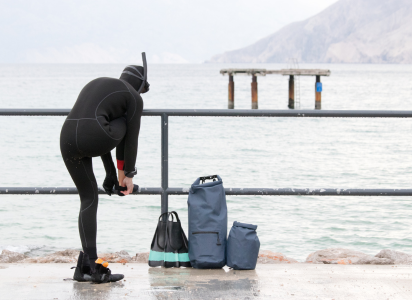One of the most essential items you need to have before heading out onto the water is a dry bag. A dry bag is essential for keeping your belongings safe and dry while kayaking.
Determining What Size Dry Bag For Kayaking You Need

If you’ve never bought a dry bag for kayaking before, you might be wondering what size dry bag you need and lucky for ya, I’ve bought quite a few over the years (some crappy ones, but a few amazing ones) and I’ll be discussing everything you need to know about choosing the right size dry bag for kayaking.
#1. Consider the Length of Your Kayak
When selecting a size for your dry bag, consider the length of your kayak.
A longer kayak will require a larger dry bag. If your kayak is 12 feet or longer, we recommend a 30-liter dry bag or higher. For shorter kayaks, a 20-liter dry bag should suffice.
#2. Think About the Duration of Your Trip
The length of your trip will also play a vital role in the size of the dry bag you need.
For a day trip, a 20-liter dry bag can be sufficient. However, if you’re planning to be out for a few days, we recommend a dry bag with a capacity of more than 30 liters. You’ll need more space to pack clothes, food, and other essentials.
#3. Consider the Type of Items You’re Carrying
The more items you plan to bring with you on your kayaking trip, the larger your dry bag needs to be.
If you’re only carrying a camera and a phone, a 20-liter dry bag can be enough. But if you’re carrying additional gear such as tent, sleeping bag, clothes, and food, you’ll need a larger dry bag.
A 30-liter dry bag or higher is recommended for carrying camping equipment.
#4. Think About How You’re Planning to Use the Dry Bag
The type of kayaking you’ll be doing will also play a role in choosing the size of your dry bag.
If you’re planning to use the bag for whitewater kayaking, you’ll likely need a smaller bag to keep it out of the water. If you plan on touring, choose a larger size bag to hold more supplies.
#5. Don’t Forget About the Importance of Compression Straps
Lastly, the compression strap on your dry bag will also impact how much it can hold.
Compression straps help to get rid of excess air, making it possible to manage space better. If you need to bring more gear, choose a dry bag with compression straps.
What Will a 5 Liter Dry Bag Hold?
A 5 liter dry bag is one of the smallest sizes available and is typically used for carrying smaller items such as a camera, phone, or keys. It can also be used to store snacks and other small items.
This size dry bag is not designed for carrying large items such as camping equipment or clothing.
How Big is a 20 Liter Dry Bag?
A 20 liter dry bag is roughly 17 inches by 9.5 inches, making it a good size for carrying smaller items for day trips or short weekend trips.
It’s big enough to store some clothes and other essentials, but not large enough for camping gear or larger items.
If you have to choose between a 5 liter and a 20 liter dry bag, I’d go for the 20 liter one.
Do You Leave Air in a Dry Bag?

Leaving a little bit of air in a dry bag is a good idea because it will help to protect your belongings from getting squished or damaged and it can float in the water.
However, you should use the compression straps on the dry bag to get rid of too much air so that it can hold more items.
3 Recommended Dry Bag Brands
If you’re looking for reliable, durable dry bags for your kayaking trips, consider one of these three brands.
#1. Sea to Summit
This brand is well-known in the outdoor community and offers a wide variety of sizes and colors to choose from. Their dry bags are made with waterproof materials that will keep your belongings safe and dry.
I highly recommend their dry bags!
#2. Earth Pak
This brand offers a range of sizes and features an air-tight seal to keep out water. Their dry bags are lightweight yet durable, making them ideal for kayaking trips.
#3. NRS
NRS is another popular brand that produces high-quality waterproof dry bags designed specifically for kayaking and other outdoor activities. Their dry bags are made with durable materials and come in a variety of sizes.
Summary
Before you go out and buy a dry bag for kayaking, consider the length of your kayak, the duration of the trip, the type of items you plan to carry, and how you plan to use the bag.
Your choice of dry bag will determine how much space you have to store essentials, so choose wisely. Remember, in the case of dry bags, size does matter! If you’ve got a few extra bucks, opt for a quality and nice sized dry bag!
